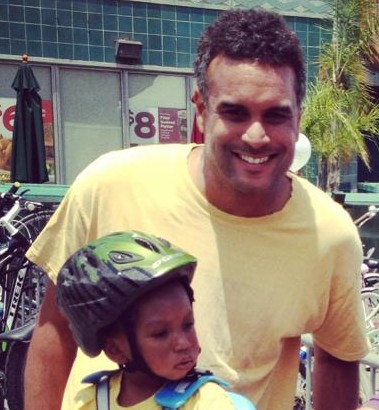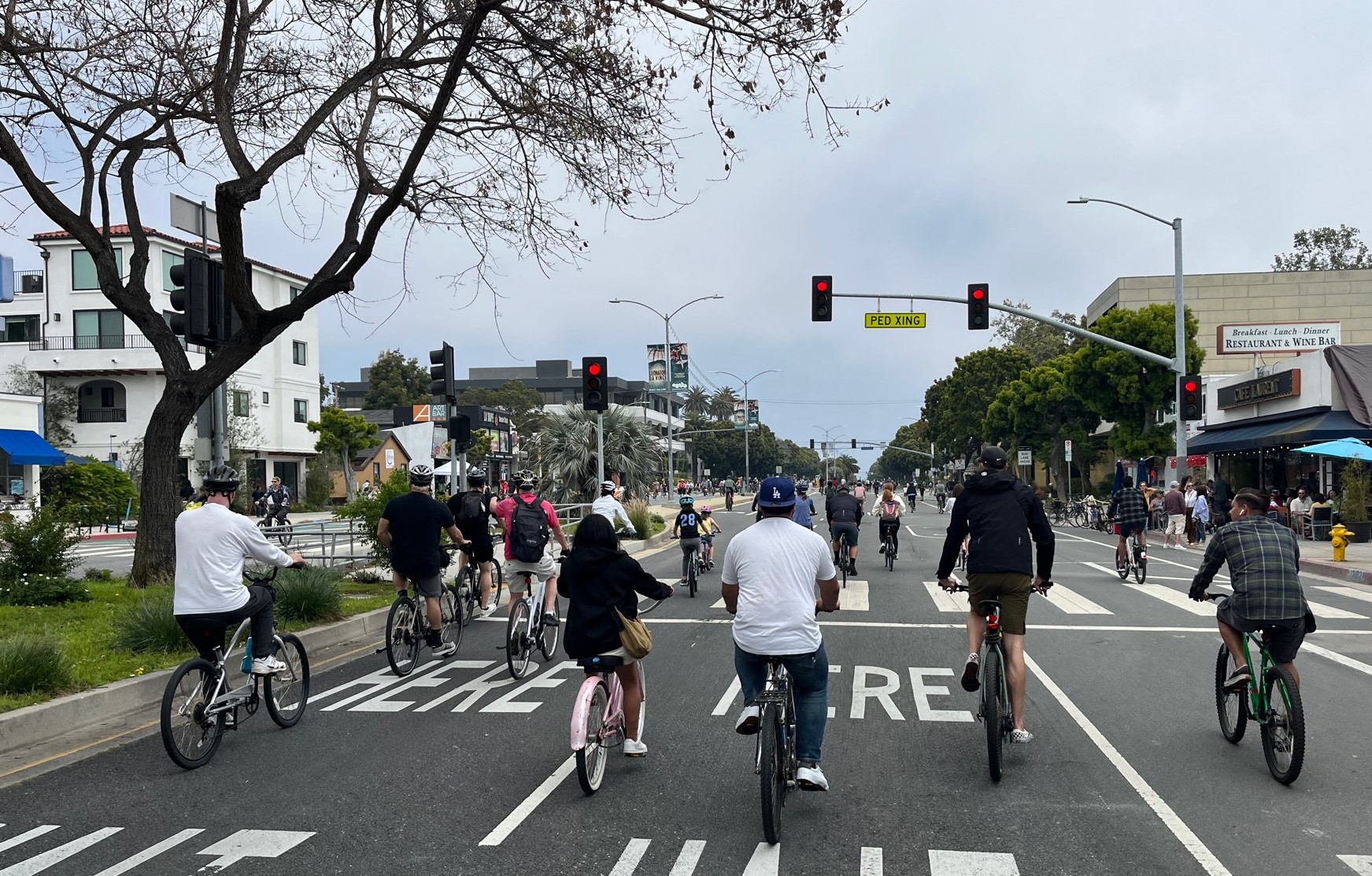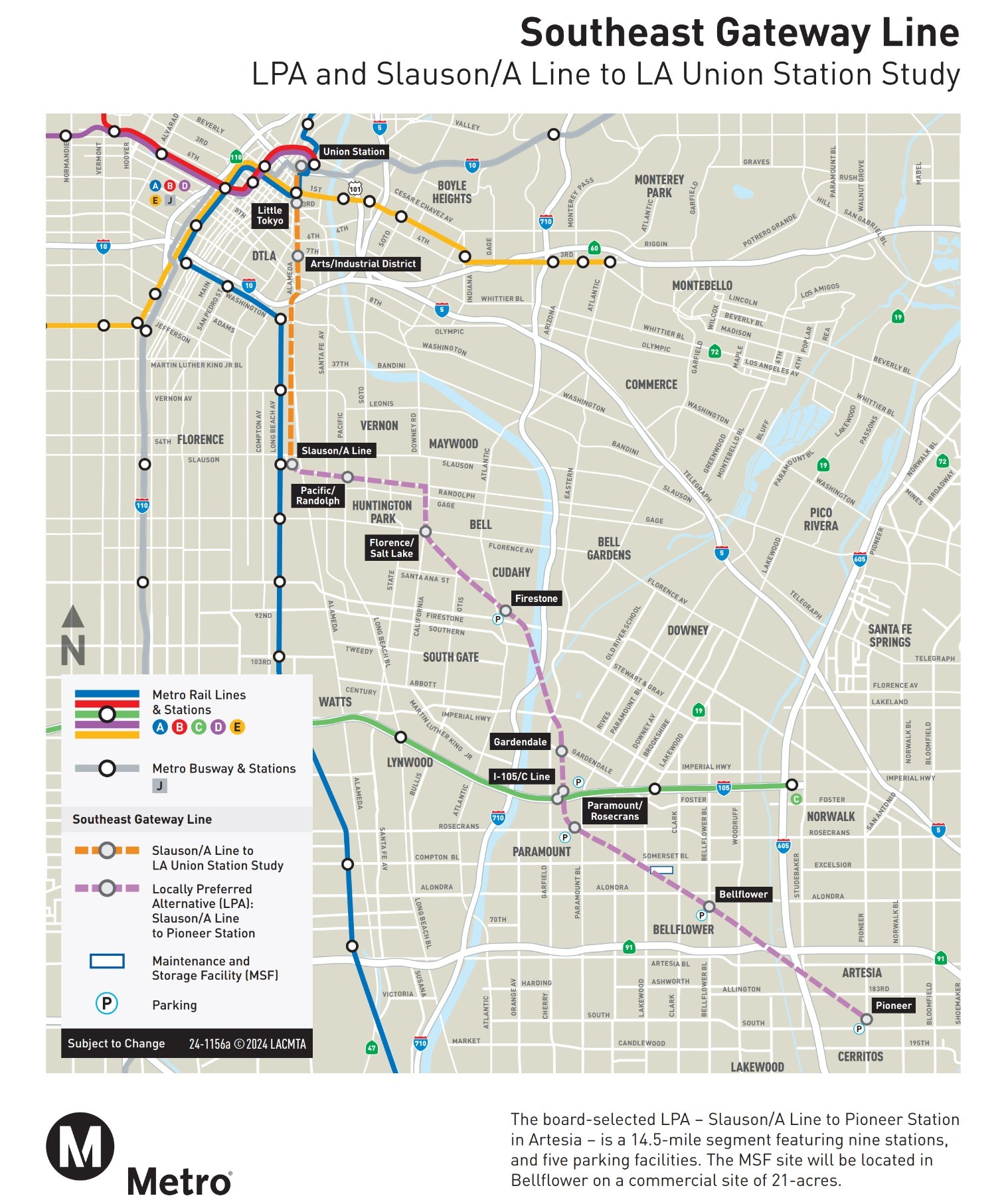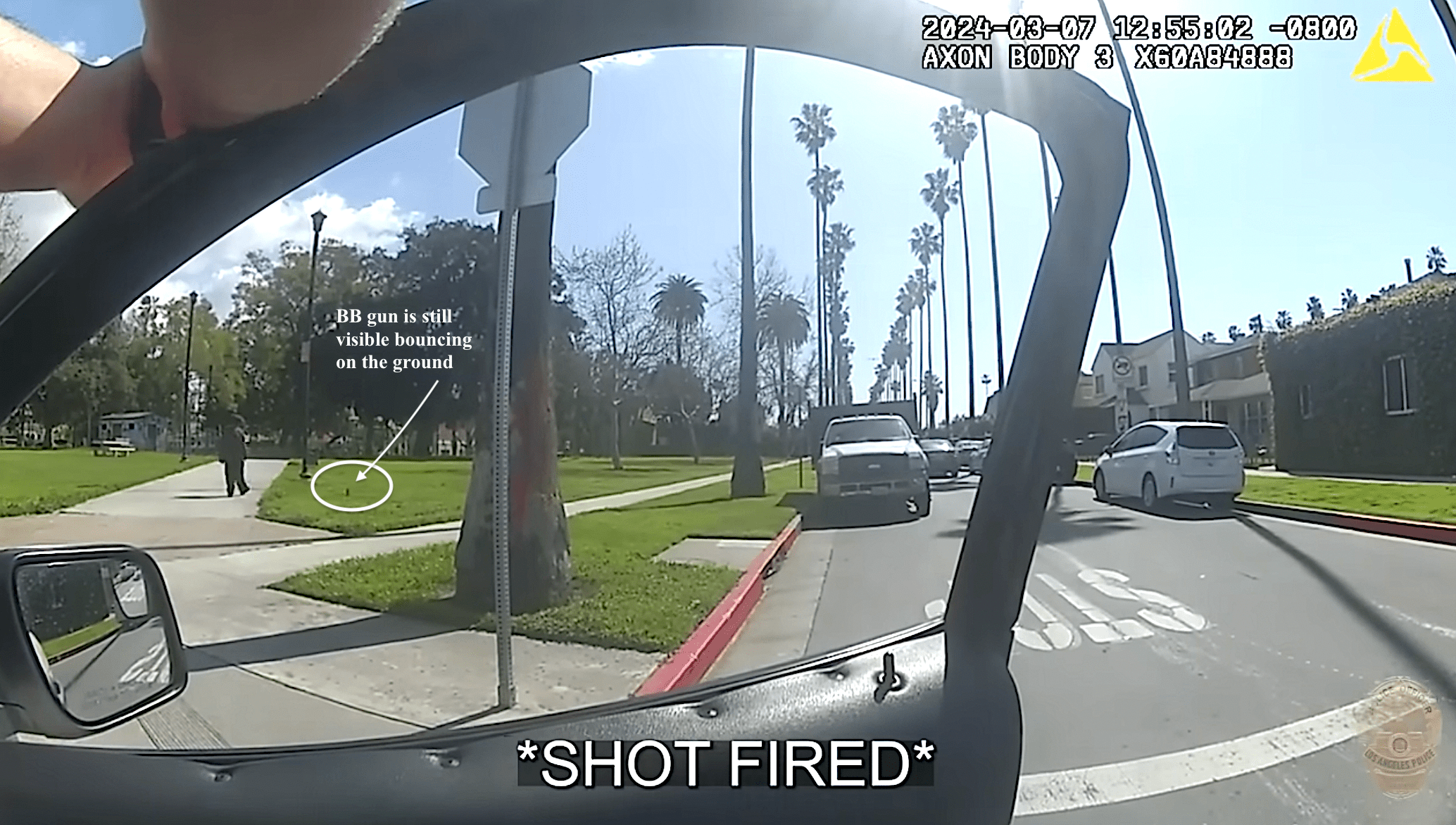Community Voices on LA Mobility Plan – CHC’s Carson and Lewis Ctr’s Huff
10:17 AM PDT on March 28, 2014
Streetsblog L.A. is continuing coverage of Los Angeles' draft Mobility Plan 2035. The draft plan is out for comment; SBLA profiled it here. The public is encouraged to submit comments via email, or at a series of Planning Forums taking place through April 12th. The next forum is tomorrow, Saturday March 29th, 9 a.m. to noon, at Boyle Heights City Hall, 2130 E. First St., L.A. 90033.
Streetsblog has asked some local livability leaders to respond to a few simple questions telling us their opinions of the city of Los Angeles draft Mobility Plan 2035. Earlier in the week, SBLA published responses from Betty Avila, Jeff Jacobberger, Carlos Hernandez , and Lois Arkin. Today's respondents are Community Health Councils' Malcolm Carson and UCLA Lewis Center's Herbie Huff.
One quick note on terminology: For this article, the following words are more-or-less interchangeable: Mobility-Transportation and Element-Plan. The document calls itself the “Mobility Plan” though it’s also referred to as the “Mobility Element” or the “Transportation Element” of the General Plan.
D. Malcolm Carson is General Counsel and Policy Director for Environmental Health at Community Health Councils, a nonprofit health policy organization located in L.A.'s Crenshaw District. Malcolm and his team at CHC work to improve mobility, create more open space, improve air quality, and reduce exposure to toxics in low-income communities of color around Los Angeles. Carson is a former City of Los Angeles Transportation Commissioner and current Mayoral appointee to the South Area Planning Commission.
What's your overall opinion of Mobility Plan 2035?
Carson: Mobility Plan 2035 is a great first step in encouraging and supporting non-motorized modes of transportation and transit through advancements in design, technology and investment. I do think that it could be improved with stronger and more specific policies and guidelines.
The Plan has a strong emphasis on multi-modal safety, infrastructure and encouragement. The “Enhanced Network” framework recognizes the importance of transportation choices. There’s recognition of streets as “public space” for people, not just motor vehicles. The Complete Streets Manual introduces new street design guidelines that supersede outdated engineering policies. The Plan recognizes transportation’s impact on public health.
The most important area that needs work is the unclear process for implementation, prioritization, and setting timelines. How will projects be prioritized for implementation? We would urge that safety, multi-modal, public space and goods movement treatments be prioritized in locations and communities with the highest need (based on traffic injuries/fatalities; vehicle speeds; private vehicle access; air pollution; lack of transit connections; significant users, such as school children; etc.)It’s not entirely clear how much teeth the Complete Streets Manual will have when confronted with outdated state standards and reluctant LADOT engineers. We would like to see language mandating complete streets as the default for all street improvement projects in the city. For example, there are a ton of streets in Los Angeles that are classic candidates for the "4-3" road diet (i.e. they have 4 lanes of traffic, no median/turn lane, and less than 25,000 vehicles a day). Why not just establish that whenever such a street comes up for repaving, it should be converted into a complete street with two lanes of traffic, a turn lane and bike lanes? Similarly, we’d like to see safety and active transportation treatments such as bulb-outs, longer signalized pedestrian times, bicycle facilities, high-visibility crosswalks, and limiting right turns during school hours become standard within a half-mile radius of schools, with a goal of transforming the environment around a given number of schools annually.
Herbie Huff is a research associate at the UCLA Lewis Center for Regional Policy Studies and Institute of Transportation Studies. She used to write bicycle and pedestrian master plans for a living. She rides bikes and buses for transportation. She is a board member at the L.A. County Bicycle Coalition (LACBC) and one of Mayor Garcetti's appointees to the L.A. Bicycle Advisory Committee. As with all of our respondents, the opinions she has expressed are her own and not on behalf of any of the organizations.
Herbie Huff prefaces her comments:
Huff: These are some initial impressions pulled from a first reading of the mobility element. I still have to look through the Complete Streets Manual, and I haven’t revisited the maps in depth, though I did review the draft networks in detail at an LACBC Planning Committee meeting during the plan development process. At this point I have more questions than answers, probably.
What’s your overall opinion of Mobility Plan 2035?
It’s a huge deal to put the nail in the coffin on our old mobility element. The people who worked on this new document deserve credit for articulating, basically ex nihilo as far as official city positions go, a progressive vision for multimodal transportation and a shift from our car-centered, road-widening, 1950s ways. So many of the battles advocates have fought over the past 5-10 years -- from bike lanes to bus-only lanes to safe crossings -- have been about the conflict between vehicle throughput and, well, every other value or function a street can have. Finally, we have a document that officially recognizes streets as public assets that need to be safe, enable biking, walking, and transit, and function as public spaces.
Further, the Draft Mobility Plan seems to have incorporated (to varying degrees from lip service to action plan) almost every good idea that is stressed in urban planning education today. From un-bundling parking to low-impact development to safe design speeds to bike corrals, the Mobility Element gives so many necessary, innovative, productive ideas official endorsement in the city of L.A.
Where can the Draft Mobility Plan be stronger?
I was talking with my colleague, Madeline Brozen, about how the process and deliberations about MyFigueroa would be different if we had this Mobility Plan instead of the current Mobility Element. We had to laugh, because very little would change. There would be a visionary document supporting the project, but that wouldn’t necessarily change the decision-making process. This is not a problem unique to the Draft Mobility Plan, but rather one that is endemic to many plans, and it has two parts: the first has to do with specificity, and the second has to do with decision-making processes.
Plans that talk around trade-offs (read: most plans), use broad, vague language, and are short on specifics about priorities and phasing -- these plans can easily evade objection, but they are also less powerful in a practical argument. I think bike advocates knew this, or at least intuited it, when we pushed for very specific implementation targets in the bike plan. Those targets are verifiably being met or not met at any given moment in time. The mobility plan, upon my first reading, could use more implementation metrics. The organization of the plan also does a poor job of distinguishing between what the city controls (example: infrastructure) and what it influences but does not completely control (examples: transit service, development, mode split). We can set targets for the latter category and we can and should push toward them, but from an accountability standpoint, the important targets concern the things we as a city control. We need as much specificity around those things as we can bear.
I and several other Bicycle Advisory Committee members are concerned about what is or is not lost in “folding” the 2010 Bike Plan into this new document. So much effort went into naming very ambitious and specific bicycle facility implementation goals, and these are lost in the new document. The specificity around bikeway types and feasibility is lost, too. And the ghosts of “designated but infeasible” haunt Mobility Plan 2035, now wearing a new term, “Deferred Backbone.”
What do you like best in the plan?
Where I applaud the mobility plan and have written “YES” and “AWESOME” in my notes are the moments when it gets really specific. Doubling the Measure R local return dedicated to bike/ped. Setting targets for the bicycle-enhanced network (though I want these targets to be higher). LACBC has catalogued some of the most awesome things in the plan really well in their blog post. The lack of similar concrete goals around other important issues like parking reform, sidewalk repair is an indication that these things could get short shrift in implementation. Advocates should push for very specific targets on some of these other items.
Huff concludes with some questions and ruminations regarding decision-making:
Again, this critique is more one of the way we do planning today than of this document in particular. It’s ironic that a plan with such a concerted outreach efforts would do such a poor job of making sense to a lay reader. Too many statements in the plan don’t address, in an honest way, the governance structure (with respect to Metro, for example) or the real challenges and fiscal constraints the city faces. The plan does a poor job of explaining its own role in decision making, too. I wish there was a very clear delineation of the various parts and players:
1) government policies that constrain the City’s ability to deliver on its new vision for mobility (e.g. theCalifornia MUTCD, Metro service cuts)2) broader changes in the economy and demographics, and3) the City Council itself.
Advocates have learned, through the Bike Plan process, that City Council can approve a bold document, and then individual council members can support or not support its implementation at their whim. Mobility Plan 2035 doesn’t make key facts like this clear to the lay reader.
In 2014, the way we do planning should be really transparent, democratic, and accountable. Let’s publish the internal documents about why some bikeways are “deferred.” Let’s say who the decider is and when they decide. Of course, a plan can’t do everything to educate citizens, but this plan could use more of a view of the processes of implementation and the key changes that are needed to achieve its laudable objectives.
Perhaps add a section on the “anatomy of a project” that describes the process (staff writes a winning grant, Council approval, budgeting) and the key players (Bureau of Street Services, L.A. Department of Transportation, City Council)? Maybe I am just identifying a role for Streetsblog…
Share your thoughts on Mobility Plan 2035 by attending a community forum and commenting on the draft plan.
Stay in touch
Sign up for our free newsletter
More from Streetsblog Los Angeles
This Week In Livable Streets
Active Streets Mission-to-Mission, LAPD reports on its use of force in 2023, Pasadena Transit plans, Metro subway construction, and more
Eyes on the Street: Santa Monica Connection from E Line Bike Path to Downtown Is Almost Complete
“Always be closing gaps in your bikeway network.”
CicLAvia Opens Venice Boulevard – Open Thread
CicLAvia opened six miles of Venice Boulevard - from Culver City Station to Venice Beach
LAPD shoots, strikes unarmed unhoused man as he walks away from them at Chesterfield Square Park
The newly released briefing video depicts Robles as non-compliant and claims officer Gomez-Magallanes shot him for pointing a weapon at officers, but body cam footage shows Gomez-Magallanes continued to fire at - and ultimately hit - Robles after he turned away and tossed the BB gun aside.







